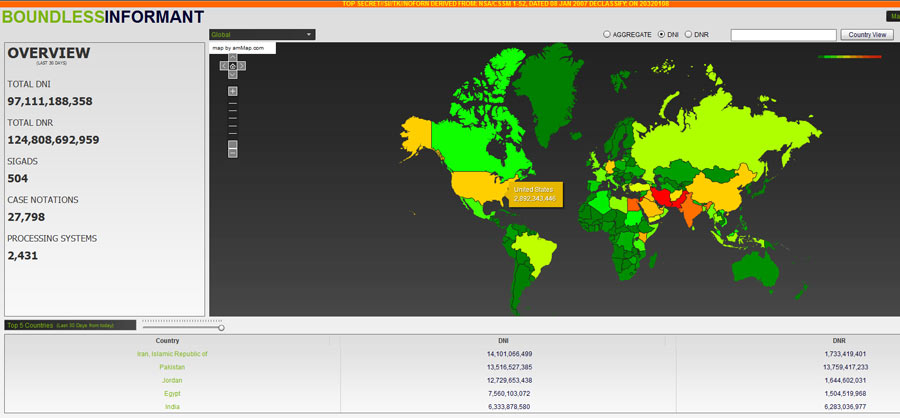Read more of this story at Slashdot.
Shared posts
Sony's PS4 To Have Less Stringent DRM Than Microsoft's Xbox One
Reader gorbax asks: I’ve been wondering for a while,...

Particle image velocimetry of a wake (from N. Vandenberge et al.)

Smoke wire flow over a wing (from T. Omer)

Dye visualization on an oscillating cylinder (from M. Canals)

Supersonic oil flow visualization over a cylindrical element (from P. Danehy et al.)

Composite dye visualization (left) and schlieren photograph (right) of a droplet impact (from A. Wilkens et al.)

Infrared thermographic visualization of boundary layer transition on a wing in flight (from W. Saric et al.)
Reader gorbax asks:
I’ve been wondering for a while, actually, how do we know when the method of flow visualization doesn’t actually alter the flow of a fluid itself?
This is a great question and one that fluid dynamicists have to deal with all the time. Ideally, we’d love to measure everything we want from a flow at all points at all times without doing anything to affect it. In reality, however, that just doesn’t happen. Some measurement techniques are less intrusive than others, but just about everything risks having some effect. This raises two questions: 1) How small can we make that effect? and 2) Do we even care if we’re affecting the flow?
With regards to the first, the onus is typically on the experimentalist to show that whatever visualization technique he/she uses is not significantly affecting the flow. For something like particle image velocimetry, which requires seeding the flow with particles, this means selecting particles that follow the flow rather than changing it and considering carefully how and where to seed the flow such that any added vorticity from the injection does not alter the flow significantly. Checking for this can be done many ways, for example with comparisons to other measurement techniques (with and without seeding) or by comparing to simulation.
The second question—do we care?—is also a significant consideration. Because the purpose of flow visualization is often to get a qualitative feel for the flow field rather than quantitative information, it is often not a significant concern if there is some slight effect from the visualization technique. This can often be the case with smoke-wire and dye visualizations where we just want to see what’s going on.
Finally, there are some instances of flow visualization which are completely unobtrusive to the flow. Schlieren photography and infrared thermography are two examples. Both are optical techniques that act from a distance and take advantage of extant flow properties to make certain features visible. The real key is knowing what technique(s) will work for the flow you have and will give you the information you want. After that, it’s all about proper and thorough execution. (Photo credits: N. Vandenberge et al., T. Omer, M. Canals, P. Danehy et al., A. Wilkens et al., W. Saric et al.)
The Lepsis Is a Terrarium For Growing Edible Insects At Home
Read more of this story at Slashdot.
when you realise your phone sex is actually a threesome

when you realise your phone sex is actually a threesome
shortformblog: So you’re about to fly, but your plane is stuck...
So you’re about to fly, but your plane is stuck on the tarmac. It’s really hot—because the airport in question is in Vegas. Minutes turn to hours. People are starting to go crazy, and a couple of people have passed out. What do you do? If you’re like the people on this flight, you break out into a singalong of “I Believe I Can Fly.” Which, incredibly, makes the whole wait kind of worth it. (ht Gawker)
I flew out of Vegas a few days ago and it was exactly like this, but with turbulence.
sometimes ?butiwouldratherbereading=thelastdinosaurcomicever works TOO well and is also sad
| archive - contact - sexy exciting merchandise - cute - search - about | |||
 |
|||
| ← previous | June 10th, 2013 | next | |
|
June 10th, 2013: Over the weekend I was given a bag of sausage and they were delicious when I cooked them the next morning. If you can ever discover circumstances where new people will give you a bag of raw sausage, I recommend you chase them down. One year ago today: you know that awesome book everyone suspects was ghost-written? i'm going to claim it here. I WAS THAT SPOOKY GHOST – Ryan 
| |||
Quando meus amigos da internet conhecem os da vida real
PS4 Video Says PlayStation Plus Is Mandatory For Online Multiplayer

It's not all champagne and high fives coming out of Sony's E3 press conference today. A "screw you, Microsoft" video the PlayStation team put together has some fine print underneath, which reads:
PS4 multiplayer online access requires PSN account & PS Plus subscription.
Now, this is far from terrible news. PlayStation Plus gives you access to a ton of free games (so long as you're a paid-up member), and competitors Microsoft have always charged for online play, something they'll continue to do with the Xbox One.
Still, the fact that online multiplayer was free on the PS3 will likely rankle a few.
We're reaching out to Sony for confirmation on this, and will update if we hear back.
119. JOHN GREEN: Make gifts for people
John Green (1977-) is an American author and video-blogger extraordinaire. He has written best-selling young adult novels including Looking For Alaska, Paper Towns and the recent The Fault in our Stars, which was named Time magazine’s best fiction book of 2012.
John and his brother, Hank, are the Vlogbrothers. They helped pioneer video blogging when they communicated only through YouTube videos for a year. They’ve since produced a wide variety of video series and have attracted a devoted army of fans known as the Nerdfighters.
I discovered John Green when a reader sent me the link to the awesome Crash Course World History series, which Green hosts and co-writes. The series tells the entire history of civilisation in over forty, very entertaining 10-minute videos. I was totally addicted to it and I highly recommend it. There have since been a Literature series and Green is currently updating a series on American History. For you science buffs, John’s brother Hank has done a biology, chemistry and ecology series. All the videos can be seen on the Crash Course YouTube channel.
This quote is taken from a 2009 Vlogbrothers video. Thanks to Kaley for submitting it ![]()
RELATED COMICS: Advice for Beginners by Ira Glass. Make Good Art by Neil Gaiman.
- Green’s official website.
- DFTBA!
UPDATE: You can pre-order this comic as a poster at DFTBA.COM!
Google To Take Waze Out Of Play For $1.3 Billion
After months of acquisition speculation, it appears that mapping company Waze may actually be, really and truly, getting bought. And the lucky winner? One of the few companies on the planet that probably doesn't need Waze at all: Google.
Israeli business publication Globes is reporting that Google will acquire the Ra'anana-based Waze for $1.3 billion. Naturally, neither party in this reported deal is confirming the details, no doubt until their ghostwriters can get the corporate blogs ready to post.
Update: Tuesday morning, the acquisition was officially announced by Google.
(See also: Google Confirms Waze Buy)
If this deal does go through, it essentially knocks a major mapping-data resource off the board. Waze's social-oriented traffic app has generated a lot of map data, independent of vendors Google, TomTom, NAVTEQ and the crowd-sourced OpenStreetMap Project.
The fact that there have been so few collections of geographic data out there for commercial use has made Waze very attractive to anyone looking to build a mobile platform without relying on Google Maps. When Apple decided to discontinue using Google Maps data in its own Apple Map app for iOS, Waze and TomTom were used for map data.
It was likely this association that helped create rumors earlier this spring that Apple was courting. Apple CEO recently publicly denied ever having made a bid for Waze.
Facebook, on the other hand, was very much in the hunt for Waze, with rumors that the social media company was throwing around billion-dollar checks to pick Waze up. Facebook reportedly backed off when it learned that Waze, unlike other Facebook acquisitions, wanted to remain open and maintain its offices in Israel.
(See also: Facebook Rumored To Purchase Traffic App Waze For $1 Billion)
It is not clear what Waze's role within Google will be when all is said and done, though early reports indicate the company will remain independent. Likely, a scenario like Google's 2010 acquisition of travel vendor ITA Software will unfold. Today, ITA is still a separate entity, and its passenger and airline reservation systems software powers travel apps like Kayak and Hipmunk.
While Waze data would be superfluous to Google's mapping data, the social aspects of the Waze app, which enables users to report traffic conditions in real time, could be folded into Google's mapping system, which would increase the accuracy and robustness of Google's existing traffic-reporting systems.
However Google opts to use Waze, one thing is for sure: Waze and its data would now be out of reach for any company that needs mapping data without going through Google. This puts Apple and Facebook in a particular bind.
Which may have been the whole $1.3-billion point.
Image courtesy of Shutterstock.
June 09, 2013

Oh man! You geeks are the best. Please help us hit 750 buyers today.
http://www.kickstarter.com/projects/weiner/trial-of-the-clone-2-wrath-of-the-pacifist
Por que segurança e eficiência energética estão sempre atreladas ao luxo?
Por que segurança e eficiência energética estão sempre atreladas ao luxo? é um post do blog Notícias Automotivas - Carros
É notório o quão defasado, em termos de segurança e eficiência energética, são os automóveis que são colocados à nossa disposição no mercado nacional. Basta uma breve busca para se encontrar, em mercados estrangeiros, carros populares que oferecem de série o tão sonhado pacote ABS, EBD, ESP, 6 ou 7 airbags e modelos que apresentam médias de consumo de combustível baixíssimas, ultrapassando facilmente casa dos 20 km/L e indo mais longe ainda em carros voltados para economia, como alguns híbridos ou diesel.
No velho continente, o programa eletrônico de estabilidade ou simplesmente controle de estabilidade, o famoso ESP, é obrigatório por lei desde novembro de 2011 e a meta é fazer com que ano que vem todos os carros que circulem na União Europeia tenham o equipamento. Já nos Estados Unidos, a obrigatoriedade vem desde 2008, determinada pela Administração Nacional de Segurança de Tráfego Rodoviário. Para justificar a obrigatoriedade, alguns números: o equipamento reduz em 73% os acidentes em que o carro poderia capotar e reduz em 33% os acidentes fatais; capotamentos representam 40% dos acidentes fatais na Europa, o que significa 4.000 vidas que podem ser salvas anualmente com a presença do ESP além de evitar 10.000 feridos (fonte: Instituto de Seguros).
Enquanto isso no Brasil, aprovamos em 2009, um ano depois do uso de airbags laterais e de cortina e dois anos depois do uso de ABS terem se tornado obrigatório nos Estados Unidos, a lei que torna obrigatório só a partir de 2014 o ABS e míseros dois airbags frontais. Chega a ser cômico, mas isso estava previsto em 1997 na redação original do Código Nacional de Trânsito, mas foi vetado pelo então presidente Fernando Henrique Cardoso sob alegação de que criaria dificuldades técnicas para motoristas (o que não faz o menor sentido) e para fiscalização.
Para confrontar o tamanho do absurdo: a presença desse tipo de airbags é obrigatória nos Estados Unidos desde 1989 e vendido desde 1970; na Europa não é imposto por lei e sim pela demanda dos consumidores e está presente em quase 100% dos automóveis.
Focando agora no que diz respeito à eficiência energética, um grande gerador de mudanças e inovações tecnológicas tem sido as normas de redução da emissão de poluentes em vigor na União Europeia. A norma Euro 5, que está em vigor, e a Euro 6 que entra em vigor efetivamente em 2015, estabelecem limites de emissão de poluentes tanto para veículos diesel quanto para veículos movidos a gasolina, GLP ou gás natural, para diversas categorias de veículos de acordo com a massa do veículo em quilogramas.
Para se ter uma ideia do quão agressiva e séria são essas normas, de 2011 para 2015 (da Euro 5 para Euro 6) estipula-se que as emissões caiam pela metade e já haviam caído 25% da Euro 4 para a Euro 5. Na prática, isso se traduz em mais investimento na pesquisa e desenvolvimento de novos motores e soluções mais eficientes. O maior exemplo disso é a tendência mundial do downsizing, motores menores rendendo o mesmo (e muitas vezes mais) que motores maiores ao mesmo tempo em que consomem menos combustível, os híbridos que combinam motores elétricos com motores a combustão tradicionais ou que fazem uso do Ciclo de Atkinson, e tecnologias como KERS e freios regenerativos.
Para atender as normas cada vez mais rígidas para redução da emissão de poluentes, as montadoras lançam mão de modernos propulsores como o dois cilindros 0.9 TwinAir Turbo usado no Fiat Panda que rende 85hp e 14,8 kgfm de torque, com Start&Stop, emissão de menos de 100g de CO2 por quilômetro rodado e consumo de 20km/L. Na cidade. Se você não é uma pessoa muito “antenada” no mundo dos automóveis confundirá facilmente o Fita Panda com o nosso Novo Uno. A carroceria realmente é parecida, mas as semelhanças param por aí.
Não existe um Uno com o propulsor 1.2 turbo supereconômico como o disponibilizado no velho continente. A versão “ecológica” do Uno é equipada com motor 1.4 de 88 cv e tímidos 12,4 kgfm de torque com uma média de consumo de combustível de inalcançáveis 11,3 km/L com etanol prometida pelo fabricante. E como você deve desconfiar a segurança (um dos focos deste artigo) é vergonhosamente inferior ao modelo italiano que obteve 4 estrelas nos testes do Euro NCAP, enquanto o brasileiro obteve apenas 1, com o boneco de testes quase saindo pela janela.
Retomando o assunto segurança e relacionando agora com eficiência energética, existe algo que muito me incomoda no mercado nacional. Ao contrário do que acontece na Europa, no Brasil é muito raro (pra não dizer impossível) que se encontre um automóvel que ofereça o pacote de segurança (ESP, ABS, múltiplos airbags) como algo que é essencial e não como se fosse um luxo. E atualmente é. É luxo ter um carro seguro. No Fiat 500 sai por mais de R$ 50 mil, pois é opcional nas versões mais caras. No New Fiesta sai por pelo menos R$ 51.490,00, também nas versões topo de linha. E esses são os modelos mais baratos com esses itens de segurança, encontrados no Brasil.
Por que não oferecer a devida segurança desde os modelos de entrada? Também nos carros populares? A mesma situação dos equipamentos de segurança é encontrada nos propulsores. O Fiat Punto equipado com motor 1.4 T-Jet sai por mais de R$ 55 mil e tem a proposta de ser um carro esportivo, mas oferece poucos equipamentos de segurança. O Smart Fortwo Coupe 1.0 turbo que não tem intensão nenhuma de ser esportivo, pelo contrário, é um carro para uso urbano, é vendido a partir de caríssimos R$ 68.500,00 com 4 airbags, ESP, ABS, entre outros.
Para quem têm condições de comprar um Audi A1, boas notícias. Com um bom conjunto mecânico alemão, o pequeno Premium conta com propulsor TFSI 1.4 com turbo e injeção direta que rende 122 cv e torque de 20,4 kgfm e todos os itens de segurança exigidos nos mercados internacionais. De visual limpo, sem apelo esportivo, mas com muita classe e com boa relação consumo-desempenho é um exemplo a ser seguido no que diz respeito à eficiência energética e segurança, apesar de existir em outros mercados versões mais econômicas com motores menores, também com turbo compressor e injeção direta. O ponto negativo é o preço de quase R$ 80.000 no mercado nacional, que apesar da redução em função do Inovar-Auto ainda é altíssimo pra grande maioria dos consumidores.
O ponto é que, raramente as montadoras oferecem um conjunto mecânico moderno e eficiente (veja que em nenhum momento falei em alto desempenho e esportividade) aliado a uma segurança de alto padrão, e quando oferecem cobram muito por isso. Enquanto temos que engolir (e vamos engolindo há anos) a versão de terceiro mundo do Volkswagen Polo (Gol), do Fiat Panda (Uno), do Fiat Punto (Palio), sem falar nos modelos globais que são depenados ao serem trazidos pra cá justamente onde poderiam se diferenciar: conjunto mecânico e itens de segurança, tudo em nome da redução de custos e manutenção da maior margem de lucro que o consumidor aceite pagar.
Resumindo: o consumidor está num beco sem saída, sem luz no fim do túnel e com um trem vindo em sua direção enquanto dirige um popular inseguro e ineficiente, que provavelmente irá capotar enquanto tenta fugir.
Por Murilo Gonzalez Balbo.
New NSA leak: BOUNDLESSINFORMANT documents the extent of NSA spying around the world

In the Guardian, Glenn Greenwald and Ewen MacAskill leak a description of another NSA top-secret program, this one codenamed "BOUNDLESSINFORMANT." This is apparently a tool that helps spies keep track of which snooping tools they can deploy in which countries, and it produces pretty, color-coded maps showing where the NSA spying powers are strongest. The Guardian has excellent notes on how this fits in with the ongoing fight between the US Senate and the NSA on whether and how the NSA spies on Americans:
The Boundless Informant documents show the agency collecting almost 3 billion pieces of intelligence from US computer networks over a 30-day period ending in March 2013. One document says it is designed to give NSA officials answers to questions like, "What type of coverage do we have on country X" in "near real-time by asking the SIGINT [signals intelligence] infrastructure."
An NSA factsheet about the program, acquired by the Guardian, says: "The tool allows users to select a country on a map and view the metadata volume and select details about the collections against that country."
Under the heading "Sample use cases", the factsheet also states the tool shows information including: "How many records (and what type) are collected against a particular country."
A snapshot of the Boundless Informant data, contained in a top secret NSA "global heat map" seen by the Guardian, shows that in March 2013 the agency collected 97bn pieces of intelligence from computer networks worldwide.
They quote Judith Emmel, an NSA spokesperson who says, "The continued publication of these allegations about highly classified issues, and other information taken out of context, makes it impossible to conduct a reasonable discussion on the merits of these programs." However, the NSA would not admit the existence of these programs (not even to the senate), prior to this.
Boundless Informant: the NSA's secret tool to track global surveillance data ![]()
Atomic bombs help solve mystery: does the adult human brain produce new neurons?

Radioactive carbon-14 atoms released by atomic bomb tests are helping scientists determine new neurons produced in the brain (credit: Spalding et al./Cell)
A study in the journal Cell reveals that a significant number of new neurons in the hippocampus — a brain region crucial for memory and learning — are generated in adult humans.
“It was thought for a long time that we are born with a certain number of neurons, and that it is not possible to get new neurons after birth,” says senior study author Jonas Frisén of the Karolinska Institute.
But no one could check this, because there was no way to date the birth of neurons in humans.
Carbon-dating neurons
To do that, Frisén and his team developed an innovative method for dating the birth of neurons that takes advantage of the elevated atmospheric levels of carbon-14, a nonradioactive form of carbon, caused by above-ground nuclear bomb testing more than 50 years ago.
Since the 1963 nuclear test ban treaty, atmospheric levels of “heavy” 14C (carbon-14) have declined at a known rate.
When we eat plants or animal products, we absorb both normal and heavy carbon at the atmospheric ratios present at that time, and the exact atmospheric concentration at any point in time is stamped into DNA every time a new neuron is born. Thus, neurons can be “carbon dated” in a similar way to that used by archeologists.

To count neurons in the hippocampus, Swedish researchers injected a substance that made them glow in different colors to distinguish non-neuronal cells from neurons. Shown here: an image of a transgenic mouse hippocampus (credit: Nikon Small World Gallery)
The researchers measured the carbon-14 concentration in DNA from the hippocampal neurons of deceased humans. They found that 1,400 new neurons in the dentate gyrus.area are added each day — 1.75% per year — during adulthood, and that this rate declines only modestly with age, suggesting that adult hippocampal neurogenesis may contribute to human brain function.
A verdadeira história de Faroeste Caboclo
Em entrevista concedida a Leoni, em 1995, para o livro Letra, Música e Outras Conversas (que está fora de catálogo, mas deve ganhar segunda edição em breve), Renato Russo explicou como surgiu a música que acabou se transformando no filme que entrou em cartaz recentemente, protagonizado por Fabrício Boliveira e Ísis Valverde. E revelou também que nutria o sonho de que aquela canção épica, com 9 minutos e 10 segundos de duração, um dia fosse transformada em filme.
Renato: ‘Faroeste Caboclo’ escrevi em duas tardes sem mudar uma vírgula. Foi: ‘Não tinha medo o tal João de Santo Cristo…’ e foi embora.
Leoni: Você não imaginou os personagens antes?
Renato: Não. Eram coisas que mesmo sem querer, sem perceber, já vinha trabalhando há muito tempo e na hora que vai escrever vêm direto. Eu sei porque foi fácil. Ela tem um ritmo muito fácil na língua portuguesa. É em cima da divisão do improviso do repente.
Leoni: O enredo também foi improvisado? Você saiu escrevendo e as ideias foram vindo?
Renato: As coisas foram aparecendo por causa das rimas. Se eu falo do professor, ele tem que parar em Salvador. Se fosse outra rima ele ia parar em outro lugar. Basicamente já sabia que tipo de história ia ser. É aquela mitologia do herói, James Dean, rebelde sem causa.
Leoni: Parece um conto adaptado.
Renato: Mas se prestar atenção tem um montão de falhas. Como é cantado as pessoas não percebem. Uma vez, o pessoal da R. Farias (produtora de cinema) queria fazer um filme. Foi quando deu pra perceber como tem furo na história. Parece que faz sentido, mas por que cargas d’água esse homem encontra esse boiadeiro em Salvador? Que história é essa de trocar, ‘eu fico aqui, você vai pra Brasília’? Por causa da filha? Por que Maria Lúcia fica com o Jeremias? Não dá pra entender! Você tem que bolar sua própria história. O máximo a que cheguei é que ela era uma viciadona e o Jeremias era tão mau que disse: ‘Se você não casar comigo vou matar o João’. Mas também não justifica. E o Santo Cristo é um banana? A menina é apaixonada por ele e ele fica andando com o Pablo pra cima e pra baixo. Ele é gay? Tem uma porção de coisas na história que não batem, mas quando a gente ouve no rádio funciona muito bem.
Nunca saberemos a opinião de Renato Russo sobre a adaptação cinematográfica dirigida por René Sampaio, e tampouco sobre Somos Tão Jovens, o filme de Antônio Carlos Fontoura que levou mais de 1,5 milhão de espectadores aos cinemas, com um surpreendente Thiago Mendonça no papel do vocalista da Legião Urbana. Quem assistiu à cinebiografia certamente lembra de Flávio Lemos, retratado no filme como objeto de paixão platônica de Renato, e que foi um dos integrantes do Aborto Elétrico antes de integrar o Capital Inicial junto com seu irmão Fê Lemos. Pois bem: em entrevista concedida a Cláudia de Castro Lima para a revista Flashback, em 2004, Flávio afirmou que “Faroeste Caboclo” foi inspirada por ele e por uma prima de Renato, Mariana. E que João de Santo Cristo seria um alterego do próprio Renato Russo nesse bizarro triângulo amoroso. Será? Confiram abaixo um trecho escaneado dessa matéria da Flashback.
Fotografia de paisagens: o que é a técnica do cartão preto
A técnica do cartão preto é utilizada para conseguir fotos bem expostas em situações onde um pedaço da foto está muito mais claro que o outro. Usamos essa técnica principalmente em momentos como no nascer do sol ou pôr do sol, quando a exposição do céu fica muito diferente da exposição da paisagem. Usar o cartão preto é uma forma fácil de já ter uma foto bem exposta sem precisar contar com a edição no Photoshop ou no Lightroom.
Não sabe o que é exposição? Baixe a apostila Aprenda a fotografar em 7 lições para aprender!
Vamos ver um exemplo? As fotos abaixo foram feitas um pouco antes do nascer do sol. Quando eu queria que o céu tivesse detalhes, ela ficou assim:

Para conseguir os detalhes da paisagem, no entanto, tive que aumentar o tempo de exposição. Consegui os detalhes do banco… Mas perdi o céu:

Usando a técnica do cartão preto, no entanto, consigo uma foto que tem a exposição correta tanto no céu quanto na paisagem:

Foto por Claudia Regina - Veja o EXIF completo desta foto no 500px
Como fazer isso na prática?
A técnica é muito simples: com a câmera em um tripé, você segura um objeto preto na frente da lente, cobrindo a metade mais clara da foto. No final da exposição, é só tirar o cartão e deixar a parte mais clara ter sua exposição correta.
Vamos para um passo a passo mais detalhado:
1. Faça a medição da fotometria tanto para a parte clara quanto para a parte escura, mudando somente o tempo de exposição. No exemplo da foto acima, usando ISO 100 e f/8, tive uma exposição de 30 segundos para a paisagem e de 3 segundos para o céu.
2. Escolha a exposição mais longa (neste caso, 30 segundos) e coloque o cartão preto na frente da lente, cobrindo somente a parte mais clara do quadro. Olhe pelo visor ou use o LCD para checar se o cartão está cobrindo de fato a parte que você quer.

3. Aperte o botão do obturador para começar a fazer a foto. Conte os segundos que se passaram e, quando faltarem os segundos da exposição mais curta, tire o cartão de frente da lente! Contar de cabeça pode ser um pouco complicado, então use um cronômetro (como o do celular.) No caso da foto de exemplo, tirei o cartão quando meu cronômetro chegou em 27 segundos (30 segundos da exposição da paisagem menos 3 segundos da exposição do céu.)
4. Pronto. Sua foto foi feita usando duas exposições diferentes e ficou linda! :-)
Dicas importantes
Essa técnica só funciona com exposições longas, pois é humanamente impossível tirar o cartão no meio de uma exposição de meio segundo, por exemplo.
O nome é “cartão preto” mas você pode usar qualquer coisa que bloqueie a exposição do sensor da câmera: só precisa ser um objeto plano, preto e fosco. Nestes exemplos usei um caderninho de anotações com capa preta que sempre carrego comigo.
Se você tem um disparador remoto é uma boa ideia utilizá-lo: você pode selecionar a opção bulb e contar o tempo direto no cronômetro.
Enquanto está segurando o cartão na frente da lente, tente fazer pequenos (bem pequenos mesmo) movimentos circulares para que a foto não saia com uma linha muito definida da diferença de exposição.
Outras técnicas
Existem filtros que fazem algo muito parecido com esta técnica: são os filtros graduados de densidade neutra (ou, simplesmente, ND-grad.) Eles também compensam a exposição de uma metade do quadro. A vantagem do filtro é a facilidade de uso. As desvantagens são limite de stops (normalmente só até 3 stops) e localização do gradiente (dá pra colocar o cartão mais pra cima e mais pra baixo, ao contrário do filtro.)

Também dá pra lidar com situações de grande diferença de luz na edição. A forma mais conhecida é usando a técnica HDR (aqui você pode ver um guia que escrevi sobre esta técnica.) Se a diferença de luz for em áreas esparsas da imagem, é legal usar HDR. Se for uma diferença bem definida, no entanto, usar o cartão preto pode ser mais prático pois a foto já sai pronta.
Você já tentou esta técnica? Quais outras usa para fotografar paisagens? Nos conte no fórum do DDF no Facebook :-)
Ad Sense
How do you turn a big piece of advertising real estate into something practical? By adding a curve and a fold or two, that’s how. Giving literal meaning to IBM’s Smarter Cities campaign, ad agency Ogilvy & Mather France seems to have found a way to get smart with urban advertising, turning a series of large-scale ads into, variously, a shelter, a seat and a ramp. They’ve even added evocative graphics—awning stripes, bench slats, traffic signage—to drive their point home. Sounds like one expensive ad campaign to us, but we like it!
Imags: Creative Review
The US is the Don Corleone of International Politics
South America – Venezuela in particular – has been the target of a coordinated campaign by the US government and private industry over the past few years. But those of us who have been paying attention know this is nothing new.
WikiLeaks recently published new documents showing that US global intelligence corporations like Stratfor and its foreign offshoot CANVAS worked hard over the past decade (aided and abetted by US Government agencies) in a failed attempt to overthrow Venezuela’s democratically elected president Hugo Chavez.
Meddling in the ‘Backyard’
The US corporate over-world has always worked closely with the CIA, the State Department and the Pentagon promoting the overthrow – known as “regime change in rogue states” – of governments that do not automatically align to US interests; or, better said, of governments that do not automatically align with the interests of the supra-national global power elite that is deeply embedded inside private and public power structures in the US.
This has been especially true throughout Latin America, traditionally America’s geopolitical and economic backyard, from Mexico to Tierra del Fuego.
For example, September 11th of this year (of all dates!) marks the 40th anniversary of the CIA-backed, financed and orchestrated overthrow and assassination of Chile’s democratically elected president, Salvador Allende.
Allende was replaced by a pro-US and pro-UK military junta headed by General Augusto Pinochet. At the time, private corporations like ITT worked hand in hand with CIA operatives promoting strikes, social turmoil and waging psychological warfare through the local media. Then it was Chile; now it’s Venezuela.
ne
In fact, the 1970s and 1980s saw the Kissinger-designed and executed ‘Condor Plan’ finance and diplomatically support various military coups and regimes not only in Chile but in Argentina, Bolivia, Uruguay, Paraguay and other countries in the region.
Such US-UK support for authoritarian and criminal regimes would only stop when some Latin American general like Argentina’s General Leopoldo Galtieri went too far by doing something really stupid, like Argentina’s 1982 invasion of the Falkland Islands.
Relatives of Argentine soldiers who died during Argentina’s 1982 war over the Falkland Islands decorate tombs at a cemetery. (AFP Photo / Angeline Montoya)
Barring that, all those US-backed coups used local military strongmen trained in the US Military’s School of the Americas in Panama to do as they pleased in their local countries, as long as: (a) they kept those countries aligned to US geopolitical imperatives which during the Cold War meant being staunchly anti-Communist; (b) accepted Chicago-Boys-style financial dependency and artificially created public debts; (c) kept local populations in permanent fear and thus ‘disciplined and orderly.’
Since the fall of the former Soviet Union, however, these tactics changed dramatically. Now US control over Latin American countries is centred on promoting ‘democracy.’ Well, actually, “the kind of democracy that we want to see,” as Hillary Clinton so eloquently put it when visiting ‘Arab Spring Egypt’ back in March 2011.
c of State Hillary Clinton (C) shakes hands with Egyptians as she takes an unannounced walk through Tahrir Square, the epicentre of the 18 days of protests that overthrew long time ally Hosni Mubarak, on Mah 16, 2011. (AFP Photo / Paul J. Richards)
Such money-controlled democracy is, of course, no democracy at all, but rather an obscene money-sloshing and media clownery system that catapults their favourite candidates into local positions of power.
When the US has its way as in Mexico, Colombia and Chile, and their candidates win local elections, then it’s all business as usual.
But when growing political awareness among the local populace elects presidents into power who prioritize the local national interest as in Ecuador (who just re-elected their fine president Rafael Correa), Bolivia (Evo Morales) and, most notably, Venezuela with Hugo Chavez, then the ‘regime change’ mega-juggernaut comes into full action.
Public and private initiative
In America, you never know whether it’s the White House and Congress running the country and the corporate over-world, or if it’s the other way around: The corporate over-world runs the White House, Congress and the country.
Recent WikiLeaks documents released on Venezuela describes Stratfor as “a company that fronts as an intelligence publisher, but provides confidential intelligence services to large corporations such as Bhopal’s Dow Chemical Co., Lockheed Martin, Northrop Grumman, Raytheon and government agencies, including the US Department of Homeland Security, the US Marines and the US Defence Intelligence Agency.”
“The emails,” WikiLeaks goes on to explain, “show Stratfor’s web of informers, pay-off structure, payment laundering techniques and psychological methods.”
The filtered emails cover a wide range of issues on the energy sector, especially oil; political change and the state of right-wing forces inside Venezuela; and the state of the country’s armed forces. They also refer to Venezuela’s relations with Cuba, China, Russia and Iran, and provide bleak projections for the economy and the financial sector.
The Serbian-based and US-supported Center for Applied Non-Violent Action and Strategies (CANVAS) is yet another such ‘global intelligence’ front of what, in practice, are organizations specializing in engineering social turmoil – even civil war – as countries like Serbia, Libya, Afghanistan and Syria have painfully learned.
The leaked emails from CANVAS had them explaining their recommended strategy for toppling governments, as in one revealing message to Stratfor:
“When somebody asks us for help, as in Vene (sic!) case, we usually ask them the question ‘and how would you do it?’. That means that the first thing is to create a situational analysis (the word doc I sent you) and after that comes “Mission Statement” (still left to be done) and then “Operational Concept”, which is the plan for campaign… For this case we have three campaigns: Unification of opposition, campaign for [September 2010 parliamentary elections] and parallel with that a ‘get out and vote’ campaign.” Very straightforward!
Stratfor Global Intelligence CEO George Friedman (AFP Photo/Ronaldo Schemidt)
Stratfor’s founder and chairman is one George Friedman, who is regularly interviewed in the Wall Street Journal, CNBC and CNN and is advisor to JPMorganChase, CitiGroup and Ernst & Young. Stratfor’s president & CEO is Shea Morenz, who for many years was a senior officer at Goldman Sachs. Not exactly corporations and megabanks bent on promoting the common good of the people of Venezuela, or of any other country in Latin America or elsewhere.
Clearly, there are no sharp lines separating these private intelligence publishers and analysts, think tanks like the Council on Foreign Relations, RAND Corporation, National Endowment for Democracy and major corporations, from public US-Government agencies like the CIA, NSA, USAID and the State Department.
In fact, throughout Latin America, lucid political observers will always keep an eye on what ‘La Embajada’ is up to. ‘La Embajada’ is Spanish for ‘The Embassy’ – not just any embassy, of course, but the local Embassy of the United States.
No surprise then to learn that this batch of WikiLeaks documents reveals US-based firms working to overthrow Hugo Chavez by assisting and financing opposition candidates like Henrique Capriles Radonsky, who was Chavez’s main opposition candidate, coming in second place in last year’s presidential elections.
Venezuela’s Democratic Unity coalition presidential candidates Capriles Radonsky. (AFP Photo / Juan Barreto)
Capriles Radonsky is strongly backed by US, European and Israeli interests, thanks to his notable alignment to those countries’ objectives in Venezuela and the region. Of Jewish background – in a country with a very tiny Jewish community – Radonsky promises to steer Venezuela away from the close ties forged by Chavez with Iran, Cuba, Russia, China and (until it was overrun and destroyed by NATO) also Libya.
Due to President Chavez’s ailing health, this public-private US initiative is again hard at work promoting all opposition forces inside Venezuela, whilst they eagerly await good news (for them) about president Chavez’s condition, hoping that he may have to relinquish the presidency he won late last year, which would mean new elections in a Venezuela without Chavez.
That would spell real tragedy for that country, as the US public-private initiative would again go into full ‘lets-get-our-boy-into-the-Miraflores-presidential-palace-in-Caracas’ Mode.upporters of Venezuelan President Hugo Chavez gather at Simon Bolivar Square in Caracas. (AFP Photo / Juan Baretto)
A tragedy not just for Venezuela but for the entire region as well, where the US continues holding full sway in countries like Colombia – whose president Juan Manuel Santos is a member of the Rockefeller-funded, New York-based ‘Americas Society’ that promotes in-roads into Latin America for the powerful Council on Foreign Relations, whose head office is just across the street from them on Park Avenue at 57th Street. And Mexico recently elected pro-US rich-boy Enrique Peña Nieto as president. Two countries where it’s business as usual.
‘Make it look like a democratic election’
In advising on how to engineer destabilisation, CANVAS told Stratfor, that “We only give them the tools to use.” Referring to the 2010 parliamentary elections, they wrote, “This year we are definitely ramping up activity in Venezuela… they have elections in September and we are in close connection with activists from there and people trying to help them (please keep this to yourself for now, no publication). The first phase of our preparation is under way.”
So, this is “the kind of democracy the US wants to see.” Or, as Don Corleone in ‘The Godfather’ would recommend to agents and operatives if he sat in the State Department or the CIA: “Make it look like a democratic election.”
Maybe Corleone’s best disciples are actually running the show after all.
AFP Photo / Geraldo Caso
Adrian Salbuchi for RT
Adrian Salbuchi is a political analyst, author, speaker and radio/TV commentator in Argentina.www.asalbuchi.com.ar
Hey, Cyprus… Let’s go back to basics!
http://rt.com/op-edge/cyprus-economics-eu-trap-224/
Can we have a common-sense explanation of why eurozone finance gone mad threatens to kill the otherwise healthy real economies of European Nations?
Much is being said about the Euro crisis exploding today in Cyprus which – like its recent Greek, Irish, Spanish, Portuguese and Italian versions – continues to fester like a malignant tumor in the body politic and economy of the European Union.
Economics: an exact science or a branch of psychology?
When times are stable and predictable, economics is treated like a science by bankers, academics, journalists and politicians aligned to the money-power elite.
All economic and social woes are explained away as resulting from the “laws of the economy” and the “invisible hand of the market”. Economists’ theorizing mumbo-jumbo never tells you is that the “invisible hand” is moved by a muscular “arm” that is directed by a perverse brain…
They try to convince us that it’s “normal” for markets, sectors and entire countries to go up, down, sideways, even dive into mega-collapses.
Such economic nonsense is normally signed by Harvard, LSE or Chicago University eggheads, suitably prestiged with Economics Nobel Prizes, and lavishly promoted by the mainstream specialized media like the Wall Street Journal and Financial Times.
However, as soon as the economic weather turns foul and the waves of currency instability, winds of banking crises and tornados of panic start rocking the boats of national and regional economies, that’s when the “science of economics” takes a really bad turn and.. it’s every many for himself! Or… every banker gets “government” to bail them out…
In economics what counts is Confidence and Trust, either real or perceived. That’s why banks’ head offices tend to look like veritable fortresses or gigantic skyscrapers, often with imposing temple-like columns, giant staircases and forbidding iron-clad gates. The idea was clear: when you enter a bank, you enter the Temple of Mammon. Financial Olympuses like the FED, Bank of England, and most every central bank beckon you to “trust” them, just as you trust your God when you enter Church; to have “confidence” in them for, like the Almighty, bankers want to make you believe that they too reign for ever and ever…
But, alas, as Peter Young writing on RT Op-Edge on Cyprus clearly explains, “confidence remains a rather intangible item. Measuring trust is rather a black art. We can never be absolutely certain we have 100% trust”.
Indeed! Trust is like virginity: once it’s gone, IT’S GONE. So when trust turns sour regarding a particular bank, or rumors arise of impending monetary collapse, or some major corporation is about to be “AIG’ed” out of existence, then “trust and confidence” turn into bank-runs, panic and deadly collapse.

What Cyprus 2013 shows is that, like Argentina 2001, “trust and confidence” have little or nothing to do with reality especially when passed through the mainstream media’s ‘Lies Machine’ for, like all perceptions, they can be manipulated to fool, confound, hide ugly truths and distort.
When things start going really bad, fraudulent lies are maintained for as long as possible to give those who DO know the truth, the chance to exit quietly and unscathed. Once they are at a safe distance then – yes: all hell can be let loose!
That happened during Argentina’s massive banking, financial and monetary collapse of 2001/2: social chaos, dozens killed in clashes with police, 50% of the population buried below the poverty line, 40% drop in GDP, and yet…. not one single private bank folded!
Deja vu “all over again”
Argentina’s then-president Fernando De la Rúa and his Rockefeller-Soros wizard Economy Minister Domingo Cavallo did everything the mega-bankers needed to weather the storm, but nothing to help “we the people” who lost life savings, jobs, homes, health benefits…
Not surprisingly, after more than a decade Argentina’s government ensures a “business as usual” banking atmosphere: politicians and megabankers always cozy up to each other (money-sloshing tends to do that…).
What about “we the people”…? Argentine workers continue biting the dust suffering all sorts of government-triggered abuse – inflation, a total foreign exchange lock-down, and ferocious tax collector persecution. Why? When President Kirchner of Argentina must choose between local workers and global megabankers, she systematically chooses the latter… with suitable media marketing of course.
Does this ring a bell? Spain? Italy? Greece? Ireland? Cyprus? Occupy Wall Streeters…?
A tip: don’t believe the mainstream media; don’t believe government liars; above all: don’t believe the megabankers!
What’s it really all about?
Example: If you’re having a drink at the pub and your mate knocks your pint of beer on your lap: Ooops! Sorry!! Acccident… If he does that again 5 minutes later: Gosh what bad luck!!! If he does that a third time: HE’S DOING IT ON PURPOSE! For some reason, it’s the guy’s behaviour pattern so best to keep away from him!
Now look at recurrent sovereign-debt banking crises: Argentina suffered four “debt crises” over the past forty years that were all so similar to what later happened in 2008 in the US; which was identical to the banking crises in the UK and Iceland, which were then repeated in Ireland, Portugal, Spain and Italy; which flared last year in Greece and today robs Cypriot workers down to their bones. Accident? Bad luck? No… It’s a System!
We are in fact dealing with major fraud perpetrated by the global megabanking establishment and done “legally” because they pay for, finance, position and control key government posts in the executive, legislative and judicial branches of governments in just about every country.
Whether Argentina or Brazil, the US or Britain, Spain or Italy, Greece or Cyprus. Same story; even the same players.
Why?
Because the global megabanking establishment have worked really hard through their media, universities and their own players to blind us to a key factor no one ever talks about: the difference between public money (issued by the State) and private money (created by private banks almost out of nothing).
Public money are the dollar, euro, peso and pound bills circulating in different parts of the world issued by public banking authorities, normally a national central bank having monopoly issuance rights. Any private citizen doing the same will, if caught, end up in jail. And rightly so because counterfeiting currency adds money to the system but no work is added to the Real Economy. The message to the people is clear: You want money? Work for it!
Private money, however, is created by the private banking system thanks to Fractional Lending which legally allows them to create loans for 10, 20 or 50 times the amount of deposits in their vaults and then charge interest for them! But private bank money is just a figure on your bank statement or a blip on your ATM screen. Like all screens it can go blank “in a moment, in a twinkling of an eye…” The message to the bankers is clear: You want money? Create it for nothing!

People instinctively understand this which is why millions of Argentinians cued at their ATM’s waiting to get some “real money” (even if Mr. Cavallo’s “corralito” limited that to 250 pesos per week). Fast forward eleven years to Cyprus: same picture of people trying to withdraw 100 euros before they’re all gone.
Sovereign Debt Death Trap
1) The private megabanker cabal uses their leverage/control over governments and politicians so legislation is passed ensuring that the central bank never provides the right amount of public money the real economy of goods, services and investment needs; i.e., no credit.
2) In come the private bankers, asking government: “You need money build highways, finance defense, education and health? No problem: we’ll lend you all you want!”
3) Government keeps borrowing and borrowing way beyond its means.
4) Bankers and politicians refinance debt again and again and again, until it balloons way beyond repayment possibilities of the victim-nation.
…Oh, the wonders of compound interest!!
Take the high road or the low road…?
Say you’re president of a country and you need to build a 100 mile road costing $ 120.000.000 over a one year period, at an investment rate of $ 10.000.000 per month to pay for steel, cement, constructors, architects, workers, etc. Everything is set to go; you have two options:
Option 1: Ask private bankers to loan you $ 120.000.000 at, say, 10% interest which means you are indebted by $ 132.000.000. The bankers funding you will, no doubt, impose certain conditions like you’re having to use such and such a construction company, insurer, consultant, cement, steel providers….
Final cost: probably closer to $ 140 to 150 million. Irresponsible modern politicians will of course just dump that debt into the federal deficit black hole. Let the next president or prime minister tackle it!
Meanwhile, compound interest makes the debt grow and grow and grow: music to mega bankers’ ears!
Even more stupid: for a country like Argentina the loan will be in Dollars even though everything they need to build the highway – cement, steel, architects, workers – is available locally and could be paid in local pesos.
Final Result: Public indebtedness in foreign currency in an amount 40 or 50% more than actually needed, that will continue to grow under compound interest…

Option 2: You order your central bank to issue $ 10.000.000 per month for 12 months in local currency. This may have a temporary inflationary effect that is immediately offset because government recovers tranches of that money through taxes that cement, steel and service providers start paying to your tax office, plus labor dues paid by workers. You repeat this for the 2nd, 3rd, 4th months until the 12th month when the highway is finished. Final equation: a good part of the currency issued immediately flowed back to your tax office (who can take it out of circulation), and the rest that remained in circulation can be recovered longer-term through road tolls. In fact most of it will be absorbed by increased demand emanating from real economic growth generated by the new highway (gas stations, diners, new towns, etc.).
Benefits: you did it with your local currency at ZERO INTEREST. If you do your homework right, the temporary transitional inflationary effect can be duly neutralized. Final Public Debt: Zero.
Now, you be the judge: what’s better, financing with public currency issued under a sovereign model, or with private banking money that makes sovereign debt grow way beyond your means, leading to inevitable Sovereign Debt crises in country after country; not by mistake but by design.
That is what megabankers want in terms of money, and that is what the Global Power Elite seeks because public debt ensures full control of countries. To add insult to injury, when bankers really screw things up as in 2008, government and media tell that we must save those nice banks because they’re “too big to fail.” You put your money in a Cyprus bank? Sorry… you’ll have to chip in with 20, 50 or 100 percent of it to save the bankers…
Now do we understand what’s behind this whole diabolical, perverse, fraudulent and immoral Sovereign Debt Crisis system?
Adrian Salbuchi for RT
Larry Page e Mark Zuckerberg reagem ao PRISM: não sabemos de nada
O PRISM foi divulgado ontem e pegou o mundo de surpresa. De uma hora para outra, ficamos sabendo que o governo dos Estados Unidos espiona praticamente tudo o que fazemos na internet. E se isso já não era ruim o suficiente, grandes empresas de tecnologia forneciam nossos dados pessoais para a Agência Nacional de Segurança (NSA).
Como assim? Então Google, Facebook, Microsoft, Apple e outras simplesmente entregavam nossos dados para o governo dos Estados Unidos? Um dia depois do escândalo estourar, ao menos duas dessas empresas vieram desmentir o fato. Larry Page, do Google, e Mark Zuckerberg, do Facebook, soltaram nota oficial (Page em um post no blog do Google e Zuck em um post no Facebook) negando conhecerem a existência do PRISM.
O impressionante é que ambas as declarações contam com muitas partes parecidas (a ênfase foi dada por nós para destacar as semelhanças):
Eu quero responder pessoalmente às revoltantes notícias da imprensa sobre o PRISM.
O Facebook não faz e nunca fez parte de nenhum programa para dar ao governo dos Estados Unidos e a nenhum outro acesso direto aos nossos servidores. Nós nunca recebemos nenhum pedido ou ordem judicial de qualquer órgão do governo pedindo informações ou metadados em massa, como o que a Verizon teria recebido. E mesmo que tivéssemos, nós brigaríamos contra agressivamente. Não tínhamos sequer ouvido falar no PRISM antes de ontem.
Quando governos pedem dados ao Facebook, nós revisamos cada pedido cuidadosamente para ter certeza que sempre seguem processos corretos e todas as leis aplicáveis, e só então damos a informação caso seja exigida por lei. Nós continuaremos brigando agressivamente para manter as suas informações seguras.
Nós encorajamos governos a serem muito mais transparentes sobre todos os problemas que visam manter a segurança pública. É a única forma de proteger todas as liberdades civis e criar a sociedade livre e segura que queremos a longo prazo.
Larry Page, do Google, em carta assinada em conjunto com David Drummond, diretor jurídico da empresa:
Você já deve ter ficado sabendo das reportagens na imprensa que afirmam que empresas de internet se juntaram a um programa secreto do governo dos Estados Unidos chamado PRISM para dar à NSA acesso direto aos nossos servidores. Como CEO do Google e Chief Legal Officer, queremos que vocês saibam todos os fatos.
Primeiro, nós não entramos em nenhum programa que daria ao governo dos Estados Unidos – nem a nenhum outro governo – acesso direto aos nossos servidores. O governo dos Estados Unidos não tem acesso direto ou uma “backdoor” para as informações guardadas em nossos data centers. Nós não tínhamos ouvido falar em um programa chamado PRISM até ontem.
Em segundo lugar, nós fornecemos dados a governos apenas quando isso está de acordo com as leis. Nossa equipe jurídica revisa todos os pedidos, e frequentemente nega quando os pedidos são muito amplos ou não seguem o processo correto. Relatos na imprensa que sugerem que o Google está dando acesso aos dados dos nossos usuários são falsos, ponto final. Até as reportagens desta semana, nós nunca tínhamos ouvido falar em um pedido amplo como o que a Verizon recebeu – uma ordem que parece ter exigido que eles fornecessem gravações de ligações de milhões de usuários. Nós estamos muito surpresos ao saber que uma coisa assim exista. Qualquer sugestão de que o Google está fornecendo informações sobre as atividades na internet dos nossos usuários em tamanha escala é completamente falsa.
Finalmente, este episódio confirma o que há muito acreditamos – é preciso ter uma abordagem mais transparente. O Google trabalha duro, dentro das leis atuais, para ser aberto sobre o tipo de pedido de dados que recebemos. Nós postamos estas informações em nosso Relatório de Transparência sempre que possível. Nós fomos a primeira empresa a fazer isso. E, é claro, nós entendemos que o governo dos Estados Unidos e outros precisam fazer medidas para proteger a segurança dos cidadãos – incluindo algumas vezes o uso de vigilância. Mas o nível de segredo sobre os procedimentos legais atuais acabam com a liberdade que desejamos.
Apesar da negativa de Google e Facebook (e de todas as outras empresas), essa história ainda está muito estranha. Vemos duas possibilidades: a primeira é que o governo dos Estados Unidos realmente tinha (e tem) todos esses acessos sem que as empresas soubessem, e isso é terrível – Obama não negou nada até agora. A segunda possibilidade é que as empresas estão mentindo, e isso é péssimo da mesma forma. Ou seja, em ambos os cenários as coisas são horríveis para nós.
Essa história ainda vai ser muito discutida durante um bom tempo, mas é bom lembrar: até agora as coisas estão terríveis para todos os lados – seja o governo dos Estados Unidos, ou as empresas, ou a população que está sendo vigiada. [Foto de destaque: encontro na Casa Branca, em 2011, entre Obama e CEOs de gigantes de tecnologia: Facebook, Google, Apple, Yahoo!, Twitter, Netflix e Oracle.]
This could be how PRISM actually works
The NSA doesn't need a secret back door to Google's servers to get the information it wants.
"Description Speculate This! is a concise, provocative manifesto advocating practices of..."
Speculate This! is a concise, provocative manifesto advocating practices of “affirmative speculation” over and against contemporary forms of speculation that quantify and contain risk to generate financial profit for a privileged few. This latter mode of speculation is predatory and familiar, its fallout evident in ongoing environmental degradation, in restrictive legal claims on natural resources in distant lands, and in the foreclosures, evictions, and unemployment resulting from the financial collapse of 2007–08. While such exploitive speculation seeks to reduce uncertainty and pin down the future, the affirmative practices championed by the authors of Speculate This! engage uncertainty, contingency, and difference, and they multiply, rather than reduce, possible futures. In these affirmative practices, social relations and the creation of goods and knowledge are not driven by the desire for financial gain or professional status. Whether manifest in open-source software, eco-communes, global activist movements, community credit networks, or experimental art, speculative living affirms our commonality. As a collaborative work coauthored by a group of anonymous scholars, Speculate This! argues for and embodies affirmative speculation.
About The Author(s)
The uncertain commons is a group of scholars, mediaphiles, and activists who explore the possibilities of collaborative intellectual labor. They remain anonymous as a challenge to the current norms of evaluating, commodifying, and institutionalizing intellectual labor. Members of the group represent a diverse set of nationalities, backgrounds, and institutional affiliations, and they participate in a range of disciplines, including cultural studies, English, media studies, philosophy, Middle Eastern studies, and South Asian studies.”
- uncertain commons - Speculate This!
Anonymous leaks PRISM-Docs
Anonymous hat Dokumente zu PRISM geleakt, die anscheinend besagen, dass es neben der massenhaften Bespitzelung praktisch aller Social Networks auch ein Programm namens GIG gibt, praktisch eine Info-Sharing-Plattform für Geheimdienste in 35 Ländern. Yay!
The GIG will enable the secure, agile, robust, dependable, interoperable data sharing environment for the Department where warfighter, business, and intelligence users share knowledge on a global network that facilitates information superiority, accelerates decision-making, effective operations, and Net-Centric transformation.
Like we said, this is happening in over 35 countries, and done in cooperation with private businesses, and intelligence partners world wide.
Anonymous releases private NSA documents regarding spying
Vorher auf Nerdcore:
NSA and FBI have direct Access to Servers of… everything
The inevitable PRISM-Twitter-Account
UK spies have access to NSA Prism, which has "direct access" to world's largest Internet companies' servers
A report by Nick Hopkins in the Guardian accuses the UK spy agency GCHQ of making use of the American NSA's Prism program, which was revealed in leaked documents earlier today -- a slide presentation claiming that the NSA had direct access to the servers at Google, Microsoft, Apple, and many other Internet giants.
According to Hopkins, GCHQ has been able to access Prism since Jun 2010. This is based on information from the same leaked slide deck, apparently:
Unless GCHQ has stopped using Prism, the agency has accessed information from the programme for at least three years. It is not mentioned in the latest report from the Interception of Communications Commissioner Office, which scrutinises the way the UK's three security agencies use the laws covering the interception and retention of data.
Asked to comment on its use of Prism, GCHQ said it "takes its obligations under the law very seriously. Our work is carried out in accordance with a strict legal and policy framework which ensures that our activities are authorised, necessary and proportionate, and that there is rigorous oversight, including from the secretary of state, the interception and intelligence services commissioners and the intelligence and security committee".
The agency refused to be drawn on how long it had been using Prism, how many intelligence reports it had gleaned from it, or which ministers knew it was being used.
A GCHQ spokesperson added: "We do not comment on intelligence matters."
UK gathering secret intelligence via covert NSA operation ![]()
PRISM: America's most paranoid fears of government surveillance are real
New leaked documents reveal the National Security Agency (NSA) and FBI directly monitor nine of the country's biggest Internet companies.



























